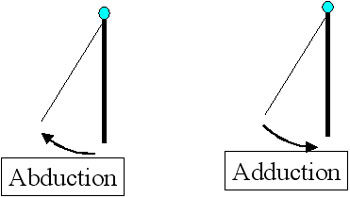

Stand behind the patient and ask the patient to shrug. The secondary elevators include the Rhomboids. Once the abdomen is reached the forearm can be taken to the back.Ī quick method to test all the above mentioned movements of the shoulder is to perform the Apley’s Scratch test. If he/she is able to bring up to his abdomen, ask him/her to take the forearm behind his back.įor testing passive internal rotation, assume the position as described for testing passive external rotation and then move rotate the arm inward.

Maintain the position as described for testing external rotation, the patient is asked to rotate his arms inward. The secondary internal rotator of the shoulder is the anterior portion of the Deltoid. The primary internal rotators of the shoulder are: Normal Range of shoulder Internal Rotation is 60–100°. This can be passively tested one side at a time by continuing the stabilization of the elbow into the waist and holding the forearm with the other hand and moving it outwards. The patient is now asked to rotate his arms outwards. The examiner moves to the front of the patient and asks the patient to flex both his forearms and the examiner stabilises both elbows into the waist to prevent the patient from substituting with adduction. The secondary external rotator is the posterior portion of the deltoid muscle. Normal Range of shoulder External Rotation is 80–90. Stay behind the patient with one hand on the acromion to stabilize the scapula and with the other hand hold the arm above the elbow and extend the shoulder passively. Normal Range of shoulder extension is 50–60°. To passively test flexion, stand behind the patient and stabilize the scapula by keeping the palm on the acromion and hold the arm above the elbow using the other hand. Normal Range of Shoulder Forward Flexion is 160–180°. This is known as the Cross Body Adduction test and this signifies pathology of the acromioclavicular joint. On testing the passive adduction movement after stabilising the scapula with the palm on the acromion and spine of scapula from behind and keeping the elbow flexed, terminally the patient may show pain in the front of the shoulder. If movement is limited in the glenohumeral joint, greater scapular movement will be seen. The examiner should watch the relative amount of scapular movement.

To accomplish Shoulder Adduction movement, the patient first flexes the arm to 90° and then moves the arm across the front of the body. The secondary adductors of the shoulder joint are: Normal Range of Shoulder Adduction is 50–75°. – Clavicle 30–50° posterior rotation and up to 15° elevation. – Humerus 60° abduction and 90° external rotation to clear the greater tuberosity from the acromion process. – 20° of scapular rotation, with minimal protraction or elevation, making a total of 60° of abduction in this phase (2:1 ratio). – Scapula minimal movement (setting phase). This is divided into 3 phases as follows: Phase 1 Normally, the abduction at the shoulder happens via the scapulohumeral rhythm which comprises of movement of the humerus, scapula and the clavicle. the anterior and posterior portions of the deltoid,.The principle abductors of the shoulder joint are: Normal Range of Shoulder Abduction is 170–180°. The following Shoulder Range Of Motion need to be tested: Shoulder Abduction

Shoulder ROM What is the normal Shoulder Range Of Motion?
#ABDUCTION MOVEMENT FULL#
If the patient is able to perform full active movements, there is no requirement for passive testing of movements. Additionally, the character of the blockade to motion can be assessed passively, with a soft and elastic end point suggesting soft tissue contractures and a firm end point pointing to a bony blockade. In the scenarios with pain, weakness and cuff injury the patient will have reduced active movements, but on testing the movements passively, one would see that the arc of motion is fairly preserved in some cases. This is because patient may have reduced movement in the joint due to pain, weakness, tendon injuries and bony or soft tissue blockade to motion. Shoulder Range Of Motion needs to be assessed actively and passively.


 0 kommentar(er)
0 kommentar(er)
